Few things are as emblematic of modern society as the nuclear family; nothing is as crucial to the nuclear family as the nuclear fallout shelter. Without a shelter, atomic war may bring swift incineration or painful death from radiation. With a shelter, one can survive with one’s loved ones…at least until the air and food runs out or the radiation finds its way in.
Living as we do in an era of unparalleled international peace and cooperation, fallout shelters might seem a ludicrous expense. During the Cold War, when World War Three seemed a perpetual twenty minutes away, matters were quite different. Many SF authors found fallout shelters inspirational. Here are five examples.
Level 7 by Mordecai Roshwald (1959)
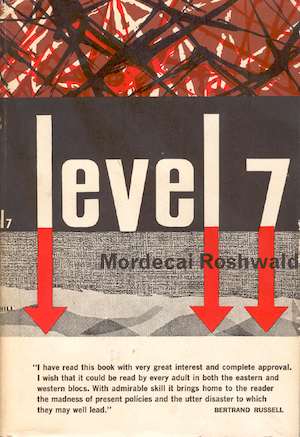
Selected for his obedience, the person known as X-127 immediately obeys orders and launches the initial salvo of humanity’s final war. Two minutes shy of three hours later, the war is over. Humanity has been saved. At least, the humans sharing X-127’s seven-leveled bunker have been saved. Everyone else, it seems, is quite dead.
The seven levels—the upper five occupied by civilians and the bottom two by more important military personnel—should be all that is needed to rebuild civilization once the surface is habitable again. Indeed, one may hope that it is more than sufficient, because levels one through five’s radiation protection turns out to be more aspirational than real. Nevertheless, the lower two levels will assuredly keep the most important people alive… for a good four months.
Roshwald appears to have been rather hostile to the idea of blindly following orders and thus dooming us all. It is not possible to determine if X-127 is a pathetic brainwashed Red, a heroically disciplined American, or something else. It is almost as though the author feels it would be wrong for anyone to obediently end life on Earth.
A Canticle for Leibowitz by Walter M. Miller, Jr.
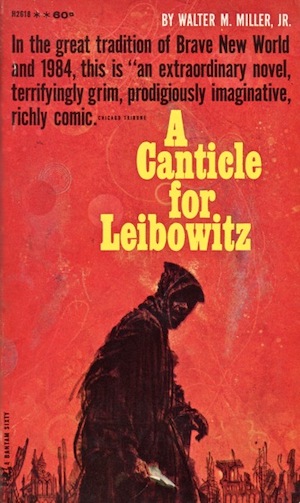
Centuries after the Flame Deluge and the Simplification that followed, the monks of the Albertian Order of Leibowitz preserve what little knowledge survived the disaster. In the time of Brother Francis, the significance of the texts the monks preserve is lost. However, enough knowledge remains that Brother Francis understands the significance of his find, out in the desert…
Beneath desolation lies the remains of structure whose sign declares it to be:
FALLOUT SURVIVAL SHELTER
Maximum Occupancy: 15
The exact nature of fallout is unknown to Francis, although he knows it is a horror that spawned monsters. The shelter appears to have more than served its purpose: thanks to tons of collapsed stone, the inner chamber of the shelter has been sealed since the Flame Deluge. It is the skull outside the shelter that concerns Francis. Could it be the mortal remains of Emily Liebowitz, wife of Sainted Leibowitz, who was thought slain in the Flame Deluge? The skull has a gold tooth as did Emily. For the pious monk, there is no question but that the skull must be Emily’s.
Canticle offers an interesting juxtaposition of the laudable goals of the Brotherhood—preserve knowledge—and the use to which it is once again put. Towards the end of novel, a despairing Dom Zerchi asks himself, “Are we doomed to it, Lord, chained to the pendulum of our own mad clockwork, helpless to halt its swing?”
The answer would appear to be “yes.” Still, A for effort.
Triumph by Philip Wylie (1963)
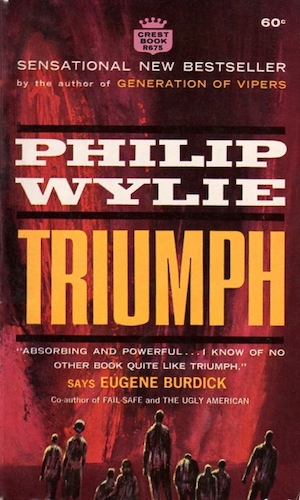
Commies! Bad! Moscow will pay any price to conquer the world. Thus, the Soviets launch an unprovoked attack on the West. The Soviet leadership is well aware that a considerable fraction of the West’s nuclear weapons will survive the attack and be sent on their way towards Eurasia. In fact, the Reds are counting on it. It’s all part of their plan to utterly depopulate the northern hemisphere save for the well-protected Soviet leadership and a small army of loyal minions. When the radiation dies down, the Communists will emerge and conquer the largely untouched southern hemisphere.
Vance Farr had the vision to mandate a shelter of unparalleled quality and the vast fortune sufficient to fund it. Sheltered within, Farr and thirteen extremely lucky Americans are the only people in North America to survive the million roentgen fallout that blankets the continent.1 What’s not clear is if this is more than a temporary stay of execution: even the years of supplies within the shelter may not allow the survivors to outwait the radiation. It seems unlikely any southern nations would undertake the expense of retrieving a handful of Americans from the lifeless hellscape that is the new America.
A million roentgens is not a typo: the Russians really, really wanted to make sure they got everyone. One of the morals of the story is that no matter how well-prepared a shelter is, it’s not that hard for a determined enemy to ensure it is not well-prepared enough. Shelters will not save America!
I note that Farr’s shelter protects a surprisingly diverse group. I suspect that the author was examining how a representative group of American classes and ethnicities would react to atomigeddon.
Children of the Dust by Louise Lawrence (1985)
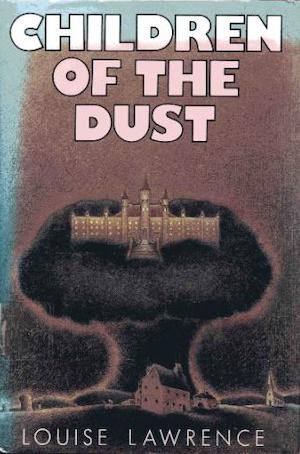
With World War Three swiftly bearing down, the British government provides its citizens with cheerfully optimistic advice while constructing impressive, well-stocked, well-sealed bunkers for the people who actually matter. As soon as the balloon goes up, Britain’s leaders and that lucky few who will serve them retreat into safety.
Sarah, her stepmother Veronica, and Sarah’s siblings William and Catherine did not qualify for admission into the secure facility. They do have sufficient distance from targets to avoid immediate incineration, helpful government pamphlets, and an entire household of materials to repurpose into an ad hoc shelter. The results are a tribute to British pluck and ingenuity. If only they’d remembered to seal the chimney…
I imagine that over in Sussex, Jim Bloggs and his wife followed the very same government leaflets to much the same effect. For some reason, British authors didn’t seem bullish about surviving WWIII. Readers outraged at the actions of the government may be assured that while it takes some time, the people in the bunkers do eventually get their just deserts.
Paranoia by Greg Costikyan, Dan Gelber, and Eric Goldberg (1984)
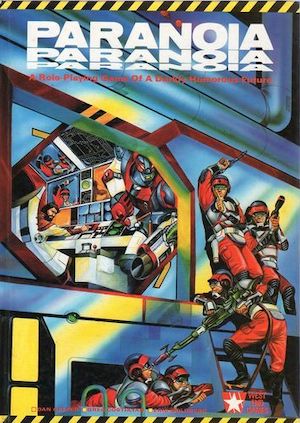
Although the nature of the calamity that threatened Alpha Complex in the backstory to this venerable tabletop roleplaying game has been lost to time, it cannot be denied that Alpha Complex succeeded in protecting its inhabitants from whatever it was, if it even existed. This is not merely because Friend Computer would order your immediate liquidation for doubting it. The population within Alpha Complex are provided with everything they could desire. Just ask Friend Computer. Remember to put your affairs in order first.
Threatening this utopian state of affairs are the Commie Mutant Traitors! Players are tasked with the job of hunting down and eliminating these undesirables. It is too bad that the Computer, having long ago forgotten what a Commie is, has adopted a very inclusive definition. Worse, every player is both a mutant and a member of a secret society, therefore by definition a traitor. Long-term survival is unlikely. Good thing each character comes with multiple clones.2
Among the many luminaries who contributed to the Paranoia game line was the late John M. Ford. Ford’s Paranoia module The Yellow Clearance Black Box Blues inspired players to scream in glee and player characters to just scream.
***
The works above represent a very small sample of a very large field. Nuclear war fiction abounds with veritable freeholds protecting their inhabitants from the aftereffects of nuclear war.3 Feel free to extol the virtues of your unmentioned favourites in the comments, which are, as ever, below.
In the words of fanfiction author Musty181, four-time Hugo finalist, prolific book reviewer, and perennial Darwin Award nominee James Davis Nicoll “looks like a default mii with glasses.” His work has appeared in Interzone, Publishers Weekly and Romantic Times as well as on his own websites, James Nicoll Reviews (where he is assisted by editor Karen Lofstrom and web person Adrienne L. Travis) and the 2021 and 2022 Aurora Award finalist Young People Read Old SFF (where he is assisted by web person Adrienne L. Travis). His Patreon can be found here.
[1]“Triumph” is not another version of “On the Beach”: the text is clear that the southern hemisphere survived. Triumph is more like Arthur Hailey’s “In High Places” (https://en.wikipedia.org/wiki/In_High_Places_(Hailey_novel)), which takes equally dim views of Soviet intentions and the likely outcome of World War Three. “Triumph” could also be read as a prequel to such settings as H. Beam Piper’s Federation stories or de Camp’s Viagens tales. Not that Wylie could have intended such a reading.
[2]“If the original is a mutant, wouldn’t the clones be as well?” I can explain why that is not the case, but to do so, I need you to first step into this handy disintegration tube.
[3]Fallout shelters will prolong life at least temporarily. But then all our lives are temporary, right?










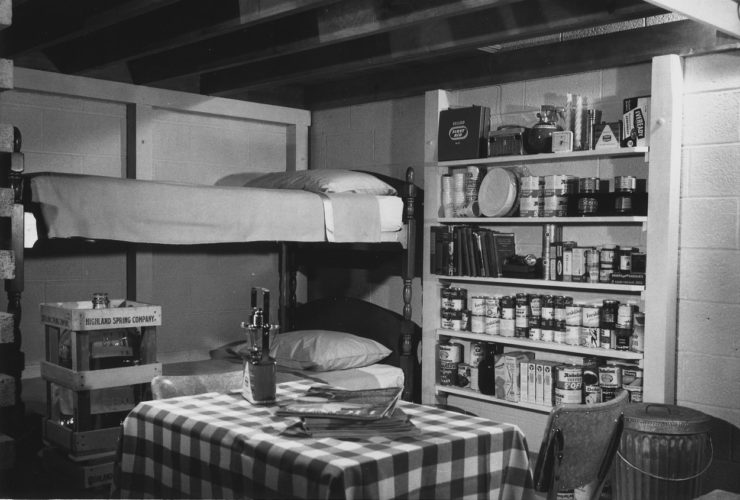
If the survivors thought to bring pigs with them, they could establish farm ham freeholds.
Its been 35 years since I read Level 7 and the dam thing still haunts me to this day, incredibly powerful book.
Farnham’s Freehold by Heinlein …
“Pulling Through” by Dean Ing, where the war is “limited”, so Our Heroes can leave the shelter after a few weeks. The US even survives!
Growing up in McLean Virginia with several primary targets within a few miles I knew exactly what my chances were. As the area became richer I think a lot of the backyard bomb shelters became wine cellars
One of my neighbours just dug up his shelter a couple of years ago. To be fair, it was not actually a fallout shelter, and it’s in Plymouth UK, where everybody was encouraged to have their own bomb shelters in WW II.
There was a somewhat faded “fallout shelter” sign on the outside of at least one brick apartment building in my Manhattan neighborhood in 2013, which struck me as wishful thinking when I first saw it in 1987: if there was a possibly useful fallout shelter anywhere in New York City. There might be, or have been, a purpose-built shelter somewhere in the city, significantly underground and probably without a sign identifying it to anyone who happened to have taken the A train uptown, with or without a fishing pole. (There was a much more recent sign in a nearby park, advising people not to eat more than one meal a week of fish from that part of the Hudson River, thank you GE.)
For a time I lived in Colorado Springs with my parents in the 1980’s while going to the University of Colorado in Colorado Springs. I was fresh out of the military and I told my mom that if the balloon ever went up, I’d get a lawn chair out and a beer and watch the fireworks. Why?
To the north of us was the Air Force Academy, possible target. To the south was Cheyenne Mountain and NORAD, as well as Fort Carson. To the east was Space Command (Now Space Force Command). There were various defense contractors in Colorado Springs. And the only way out would be to drive up through Colorado City into the mountains, on a narrow two lane road…
Like I said, I’d drink a beer and watch the fireworks.
@1 Ouch.
I would nominate Alas Babylon by Pat Frank, but while it is a good nuclear war survival story, it lacks fallout shelters. It is set in Florida, where there are few basements to hide in…
I mainly just wanted to express my happiness at seeing Paranoia show up in the list.
Those who are curious (and have about four hours to spare) can watch this video of a Paranoia game which includes Wil Wheaton and Felicia Day among the players and is really funny.
Perfect readings in these times

“The Shelter” (1961) on the Twilight Zone. It’s a television episode, but it’s a phenomenal Rod Serling story and the first thing I think about when I hear “fallout shelter.” Harrowing to this day.
@11: I’m sure I must have seen it, since I watched them all, but apparently I did not find it memorable.
not actually a fallout shelter, and it’s in Plymouth UK
With Devonport Dockyard, HMS Drake and the Various Royal Marine and Commando barracks in the surrounding area it would be more likely to become part of the fallout rather than protect from it.
A more upbeat take is presented in The Unbreakable Kimmy Schmidt, a Netflix series in which the protagonist is rescued from a fallout shelter in which she’s been ensconced by a doomsday cult preacher for 15 years. Hilarity ensues.
@7: A problem with watching the fireworks is that they’re awfully bright. ‘Day of the Triffids”,bright. But perhaps you’d be watching from inside the big kaboom anyway.
Whitley Streiber’s surprisingly good War Day does not feature shelters, but shows the effects 5 years after a limited thermonuclear war between the US and the USSR. More about the plot and the world building at https://en.wikipedia.org/wiki/Warday.
Dean Bryant@11: Probably the even-more-memorable Twilight Zone episode is ‘Time Enough at Last’, with the incomparable Burgess Meredith as the misanthropic bank clerk who likes to read his books down in the vault — which, one day, becomes a fallout shelter (thus proving the long-standing hypothesis that the only survivors of nuclear war will be librarians and bank employees). He encounters a problem with his spectacles, however….
Emergence by David R. Palmer.
I’m old enough to remember sirens being tested even in my small town in the 1950s, and of course the great surge of interest in fallout shelter construction during the Cuban missile crisis. I didn’t know anyone who actually had (or built) one, but if they were sufficiently paranoid, they would have kept quiet about it, right?
For readers not inclined to look up RPG rulebooks, it should be noted that there was, in fact, at least one actual tie-in novel released for the Paranoia game – Ken Rolston’s Extreme Paranoia: Nobody Knows the Trouble I’ve Shot in 1991. On one hand, it may be harder to find a copy of the novel nowadays than to find the game…although having read the Kickstarter/Kickstopper review you linked, those going in search of the game should clearly be careful as to which edition they acquire.
I can tell you this because the book landed in my lap during my tenure as Dragon magazine’s resident book reviewer, and on reading it I was prompted to turn in a review in the form of a Troubleshooter mission report, excerpted in part below:
“What was that half-remembered book” time: A YA novel I would have read in the late 70s or early 80s most likely, in which young people in a small town are perplexed by the gradual disappearance of their parents and other local adults, who are eventually revealed gb unir orra erybpngrq gb fbzr xvaq bs ohaxre be snyybhg furygre, jurer gur xvqf riraghnyyl ner zbirq nf jryy? Guvf fgbel unhagf zr orpnhfr V pna’g sbe gur yvsr bs zr erpnyy jul gnxvat gur nqhygf svefg naq yrnivat gur xvqf oruvaq jbhyq unir znqr nal xvaq bs frafr sbe gur cybg.
Also, I nominate Hugh Howey’s incredibly creepy “Wool” for this series, even though… all is not as it seems.
Paul O Williams’ Pelbar Cycle has a fallout shelter being rediscovered by forces from the outside in The Dome in the Forest and The Fall of the Shell.
It’s notable for how that goes down, very different to say the autocracy of The Amtrak Wars.
@20 I vaguely remember something similar from that time period with that setup but a different ending. A golf club, with an adjustable mercury weight inside, played a role near the end. In memory it feels like a Zenna Henderson story except I’m sure it wasn’t. Ever so helpful I know.
P. K. Dick’s “Foster, You’re Dead” is a great fallout shelter tale
@17: “misanthropic”? Our hero gets in trouble with his boss because he’s too chatty with the customers about literature, and delighted to read poetry to his wife. After the bomb, he’s at the verge of suicide from loneliness when he finds the library.
Stephen Nemeth and Willian Walling’s Earth Air Fire and Water features the ultimate “fallout shelter” – it’s a Cold War plan to compress and store the entire atmosphere of the Earth in an American subway system, where the only survivors of the air theft will live.
@23 – that image doesn’t jostle any memories unfortunately. And I looked at the ZH Wikipedia entry but nothing there seemed familiar either. This was a novel/novelette IIRC.
Dark Universe, Daniel F. Galouye 1961, the book the Fallout computer games actually drew heavily from (and not that short story collection they talk about), which becomes very very clear when you read it.
AndyLove@24: Point taken; it’s been awhile since I’ve seen that episode, and had forgotten that aspect of his character. Probably just projecting my own weariness with mankind onto him!
Given that we’ve included RPGs and TV episodes, I’m surprised that no one has mentioned Dr. Strangelove or: How I Learned to Stop Worrying and Love the Bomb.
@16 See also Resurrection Day by Brendon DuBois, set in 1972, ten years after the Cuban Missile Crisis led to a limited nuclear war. One result was gangs of semi-feral teenagers roaming the landscape, who as little kids had been led into fallout shelters at schools while their parents died on the surface. Eventually, they were abandoned by their teachers (who left them to find any survivors) and had to fend for themselves.
@@.-@ @5 @6 @7 @13 @15
As a kid, I grew up with duck and cover drills at school. Then reality hit when the Tsar Bomb was tested. My dad’s office, my school, and my house were all in the total destruction zone.
This, and all the shelter and post apocalyptic stories make it clear to me that I don’t want to survive.
I’ll sit on my back porch with a scotch and a cigar and relax while the fireworks go off.
So glad someone else remembers Paranoia. I played when it first came out during the Reagan years when the need to dig shelters seemed a little more imminent. My D&D group loved the game, though the early mechanics were pretty rough and the emphasis on having players actually filling out requisition forms was tedious and quickly overlooked. I ran into Marvin Minsky at some conference and got him to sign a page of one of the manuals where the homicidal central computer was thinking to itself “If only Marvin Minsky could see me now!” He got a kick out of it.
@23: You are probably thinking of Bonham’s The Missing Person’s League, where the mercury golf clubs are N pbairavrag jnl gb pbaprny gur zrephel gung jnf arrqrq gb bcra gur bhgre ragenapr gb gur furygre. Trggvat cnfg gur qrsrafr flfgrz arrqrq fbzrguvat jvfr ragveryl…
Notable that the shelters in that story agent to outsourcing against nuclear war, but a lethally polluted Earth.. A similar situation prompted the construction of the shelter in Hoover’s Children of Morrow…
@28: It’s understandable – a lot of parodies of and references to “Time Enough At Last” take that view of Bemis.
@33 Yes, that’s exactly it. Thank you. I strongly suspect that’s @20’s book as well.
@30 – that IS it! But it seems I’ve forgotten a lot of the SFnal type elements otherwise – very little from this Kirkus Review sounds familiar, and yet the reference to a “conductor” who “calls every night with instructions cued in by strains of a Brahms lullaby” is definitely something I remember. But “algae burgers” and the “Gumball KIng” triggered nothing.
I wonder how much that book messed with my head, giving me the vague worry that people I depended on might start disappearing… not an idle threat for a child of divorce in the 70s….
How about Swan Song by Robt. McCammon? That bomb shelter built in the mountains on the cheap made the Black Hole of Calcutta look good.